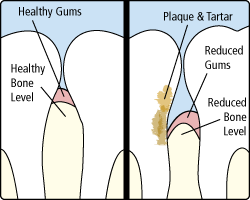Gum Disease
Gum disease, also known as periodontal disease, is one of the top reasons for tooth loss in adults, and because it is virtually pain-free, it may remain unattended until it causes tissue damage and destructin. During each regular checkup, your dentist will check for signs of periodontal disease.
What causes gum disease?
 Gum disease is caused by a buildup of plaque (a sticky clear film formed on tooth surface). If the plaque is not removed (by flossing, brushing, and regular dental cleaning), it will continue to build up and create toxins that can damage the gums. Periodontal disease forms just below the gum line and creates small pockets that separate the gums from the teeth. It has twocommon forms: gingivitis and periodontitis.
Gum disease is caused by a buildup of plaque (a sticky clear film formed on tooth surface). If the plaque is not removed (by flossing, brushing, and regular dental cleaning), it will continue to build up and create toxins that can damage the gums. Periodontal disease forms just below the gum line and creates small pockets that separate the gums from the teeth. It has twocommon forms: gingivitis and periodontitis.
- Gingivitis — This is the early stage of gum disease, when the gums become red and swollen, and bleed easily. At this stage, the disease is easily treatable.
- Periodontitis — If left untreated, gingivitis will advance into periodontitis, and the gums and supporting tissues may become seriously and irreversibly damaged. This condition can eventually result in tooth mobility and /or even tooth loss.
Certain factors can increase a patient's risk of developing periodontal disease, including:
- Smoking or using chewing tobacco
- Diabetes
- Certain types of medication such as steroids, anti-epilepsy drugs, cancer therapy drugs, calcium channel blockers, and oral contraceptives
- Bridges that no longer fit properly
- Crooked teeth
- Old fillings
- Pregnancy
While it is possible to have periodontal disease and not know it, some symptoms can include:
- Gums that bleed easily
- Red, swollen, tender gums
- Gums that have pulled away from the teeth
- Persistent bad breath or bad taste
- Pus between your teeth and gums
- Tooth mobility
- Any change in the way your teeth fit together when you bite
Preventing Gum Disease
Regular dental checkups and periodontal examinations are important for maintaining a healthy gum. You don't have to lose teeth to periodontal disease, and by practicing good oral hygiene at home, you can significantly reduce your chances of ever getting gum disease. Remember to brush regularly, clean between your teeth, eat a balanced diet, and schedule regular dental visits.
Periodontal/Gum Treatments
If you've been diagnosed with gum disease, there are a variety of treatment options depending on the details of your situation and the severity of the problem. We always start with the least invasive options, which are non-surgical. However, in more serious cases, surgery may be necessary.
Non-Surgical Treatment
The first line of defense against gum disease is a unique type of cleaning called “scaling and root planing.” In this procedure, an ultrasonic cleaning device is used to remove plaque and tartar from your teeth where regular cleaning devices can't reach: under the gum line, on the tooth, and around the root. Then, the rough surface of the tooth and the root are smoothed out (planed). This provides a healthy, clean surface that makes it easier for the gum tissue to reattach to the tooth.
If you address your gum disease before it becomes severe, scaling and root planing may be the only treatment you need. However, as with any dental procedure, after-care is vital. In order to keep your teeth in good shape and resist future occurrences of gum disease, you must brush and floss daily, eat a healthy diet, avoid tobacco use, and have regular dental checkups. Even after a successful scaling and root planing, if you don't attend to your teeth properly, it's quite likely that you'll develop gum disease again.
Surgical Treatment Options
If the tissue or bone surrounding your teeth is too damaged to be repaired with non-surgical treatment, several surgical procedures are available to prevent severe damage and to restore a healthy smile. We will recommend the procedure that is best suited to the condition of your teeth and gums. Some of the common types of periodontal surgery are:
-
Pocket Depth Reductio
-
Regeneration
-
Soft-Tissue Graft
We may need to refer you to a periodontist for some of these procedures.


 Website Powered by Sesame 24-7™
Website Powered by Sesame 24-7™